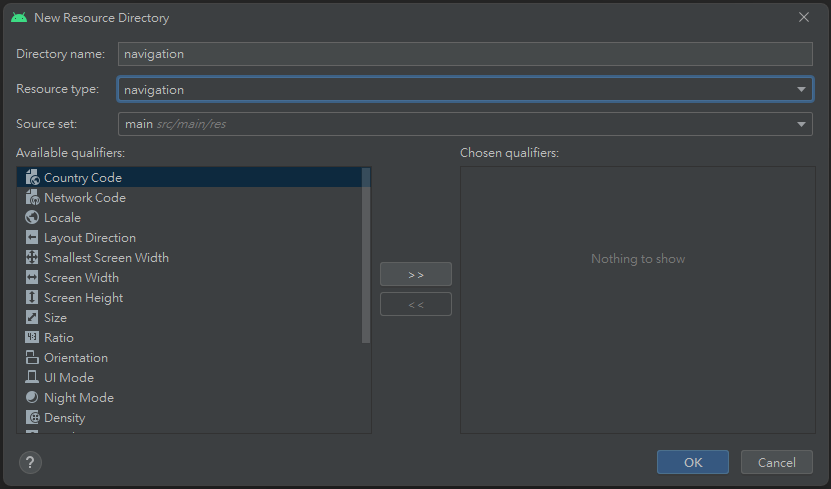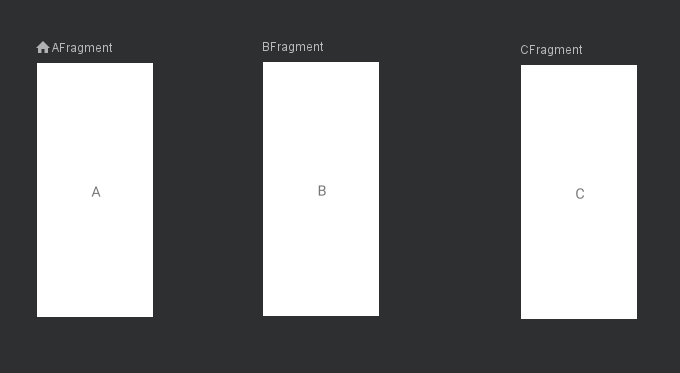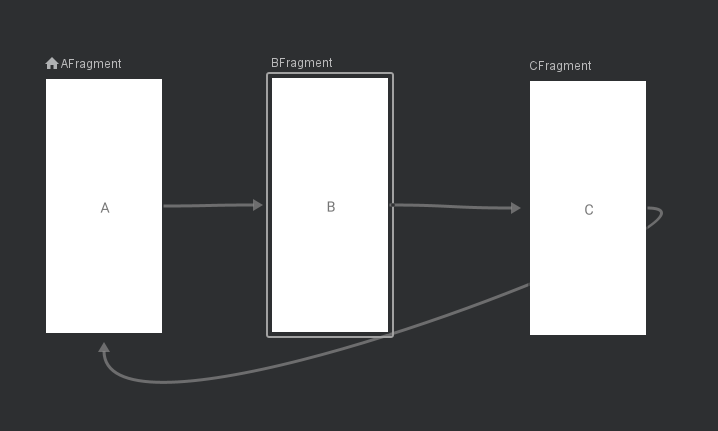🚶♂️【Jetpack】Android Navigation 創建與跳轉 (一) 範例🗺️
Android Jetpack Navigation 是一個統一的導航框架,可以讓開發者更容易地將 Android 皆常用的導航功能(如功能表、堆疊、抽屜和底部導航等)添加到應用中。
它為多個導航目的地提供一致的 API,並可以讓開發者將導航行為通用於單個或多個活動。

文章目錄
- Navigation & Safe Args 導入
- Navigation 創建 nav_graph.xml
- Navigation 引用 FragmentContainerView
- Navigation 創建 Fragment
- Navigation 添加 Fragment 到 nav_graph.xml
- Navigation 跳轉 Action 方式
- Navigation 跳轉 ID 方式
- Navigation popUpTo Action 方式
- Navigation popUpTo ID 方式
- Developer Documents Navigation
1.Navigation & Safe Args 導入
build.gradle(Module)
plugins {
id 'androidx.navigation.safeargs.kotlin'
}
android {
buildFeatures {
dataBinding true
}
}
dependencies {
def nav_version = "2.5.3"
implementation "androidx.navigation:navigation-fragment-ktx:nav_version"
implementation "androidx.navigation:navigation-ui-ktx:nav_version"
}
build.gradle(Project)
buildscript {
dependencies {
def nav_version = "2.5.3"
classpath "androidx.navigation:navigation-safe-args-gradle-plugin:$nav_version"
}
}
plugins {
id 'androidx.navigation.safeargs.kotlin' version '2.5.3' apply false
}
2.Navigation 創建 nav_graph.xml
選擇 Android Resource Directory

選擇 navigation

創建 Navigation Resource File

3.Navigation 引用 FragmentContainerView
activity_main.xml
<?xml version="1.0" encoding="utf-8"?>
<layout xmlns:android="http://schemas.android.com/apk/res/android"
xmlns:app="http://schemas.android.com/apk/res-auto"
xmlns:tools="http://schemas.android.com/tools">
<data>
</data>
<androidx.constraintlayout.widget.ConstraintLayout
android:layout_width="match_parent"
android:layout_height="match_parent"
tools:context=".MainActivity">
<androidx.fragment.app.FragmentContainerView
app:defaultNavHost="true"
app:navGraph="@navigation/nav_graph"
android:id="@+id/nav_host_fragment"
android:name="androidx.navigation.fragment.NavHostFragment"
android:layout_width="0dp"
android:layout_height="0dp"
app:layout_constraintBottom_toBottomOf="parent"
app:layout_constraintEnd_toEndOf="parent"
app:layout_constraintStart_toStartOf="parent"
app:layout_constraintTop_toTopOf="parent" />
</androidx.constraintlayout.widget.ConstraintLayout>
</layout>
4.Navigation 創建 Fragment
AFragment.kt
class AFragment : Fragment(R.layout.fragment_a) {
override fun onViewCreated(view: View, savedInstanceState: Bundle?) {
val binding = FragmentABinding.bind(view)
}
}
fragment_a.xml
<?xml version="1.0" encoding="utf-8"?>
<layout xmlns:android="http://schemas.android.com/apk/res/android"
xmlns:app="http://schemas.android.com/apk/res-auto">
<data>
</data>
<androidx.constraintlayout.widget.ConstraintLayout
android:layout_width="match_parent"
android:layout_height="match_parent">
<androidx.appcompat.widget.AppCompatTextView
android:id="@+id/next"
android:layout_width="wrap_content"
android:layout_height="wrap_content"
android:text="A"
android:textSize="50sp"
app:layout_constraintBottom_toBottomOf="parent"
app:layout_constraintEnd_toEndOf="parent"
app:layout_constraintStart_toStartOf="parent"
app:layout_constraintTop_toTopOf="parent" />
</androidx.constraintlayout.widget.ConstraintLayout>
</layout>
BFragment.kt
class BFragment : Fragment(R.layout.fragment_b) {
override fun onViewCreated(view: View, savedInstanceState: Bundle?) {
val binding = FragmentBBinding.bind(view)
}
}
fragment_b.xml
<?xml version="1.0" encoding="utf-8"?>
<layout xmlns:android="http://schemas.android.com/apk/res/android"
xmlns:app="http://schemas.android.com/apk/res-auto">
<data>
</data>
<androidx.constraintlayout.widget.ConstraintLayout
android:layout_width="match_parent"
android:layout_height="match_parent">
<androidx.appcompat.widget.AppCompatTextView
android:id="@+id/next"
android:layout_width="wrap_content"
android:layout_height="wrap_content"
android:text="B"
android:textSize="50sp"
app:layout_constraintBottom_toBottomOf="parent"
app:layout_constraintEnd_toEndOf="parent"
app:layout_constraintStart_toStartOf="parent"
app:layout_constraintTop_toTopOf="parent" />
</androidx.constraintlayout.widget.ConstraintLayout>
</layout>
CFragment.kt
class CFragment : Fragment(R.layout.fragment_c) {
override fun onViewCreated(view: View, savedInstanceState: Bundle?) {
val binding = FragmentCBinding.bind(view)
}
}
fragment_c.xml
<?xml version="1.0" encoding="utf-8"?>
<layout xmlns:android="http://schemas.android.com/apk/res/android"
xmlns:app="http://schemas.android.com/apk/res-auto">
<data>
</data>
<androidx.constraintlayout.widget.ConstraintLayout
android:layout_width="match_parent"
android:layout_height="match_parent">
<androidx.appcompat.widget.AppCompatTextView
android:id="@+id/next"
android:layout_width="wrap_content"
android:layout_height="wrap_content"
android:text="C"
android:textSize="50sp"
app:layout_constraintBottom_toBottomOf="parent"
app:layout_constraintEnd_toEndOf="parent"
app:layout_constraintStart_toStartOf="parent"
app:layout_constraintTop_toTopOf="parent" />
</androidx.constraintlayout.widget.ConstraintLayout>
</layout>
5.Navigation 添加 Fragment 到 nav_graph.xml

nav_graph.xml
<?xml version="1.0" encoding="utf-8"?>
<navigation xmlns:android="http://schemas.android.com/apk/res/android"
xmlns:app="http://schemas.android.com/apk/res-auto"
xmlns:tools="http://schemas.android.com/tools"
android:id="@+id/nav_graph"
app:startDestination="@id/AFragment">
<fragment
android:id="@+id/AFragment"
android:name="com.example.jetpackdemo.AFragment"
android:label="AFragment"
tools:layout="@layout/fragment_a" />
<fragment
android:id="@+id/BFragment"
android:name="com.example.jetpackdemo.BFragment"
android:label="BFragment"
tools:layout="@layout/fragment_b" />
<fragment
android:id="@+id/CFragment"
android:name="com.example.jetpackdemo.CFragment"
android:label="CFragment"
tools:layout="@layout/fragment_c" />
</navigation>
6.Navigation 跳轉 Action 方式

nav_graph.xml
<?xml version="1.0" encoding="utf-8"?>
<navigation xmlns:android="http://schemas.android.com/apk/res/android"
xmlns:app="http://schemas.android.com/apk/res-auto"
xmlns:tools="http://schemas.android.com/tools"
android:id="@+id/nav_graph"
app:startDestination="@id/AFragment">
<fragment
android:id="@+id/AFragment"
android:name="com.example.jetpackdemo.AFragment"
android:label="AFragment"
tools:layout="@layout/fragment_a" >
<action
android:id="@+id/action_AFragment_to_BFragment"
app:destination="@id/BFragment" />
</fragment>
<fragment
android:id="@+id/BFragment"
android:name="com.example.jetpackdemo.BFragment"
android:label="BFragment"
tools:layout="@layout/fragment_b" >
<action
android:id="@+id/action_BFragment_to_CFragment"
app:destination="@id/CFragment" />
</fragment>
<fragment
android:id="@+id/CFragment"
android:name="com.example.jetpackdemo.CFragment"
android:label="CFragment"
tools:layout="@layout/fragment_c" >
<action
android:id="@+id/action_CFragment_to_AFragment"
app:destination="@id/AFragment" />
</fragment>
</navigation>
AFragment.kt
class AFragment : Fragment(R.layout.fragment_a) {
override fun onViewCreated(view: View, savedInstanceState: Bundle?) {
val binding = FragmentABinding.bind(view)
binding.next.setOnClickListener {
val action = AFragmentDirections.actionAFragmentToBFragment()
findNavController().navigate(action)
}
}
}
BFragment.kt
class BFragment : Fragment(R.layout.fragment_b) {
override fun onViewCreated(view: View, savedInstanceState: Bundle?) {
val binding = FragmentBBinding.bind(view)
binding.next.setOnClickListener {
val action = BFragmentDirections.actionBFragmentToCFragment()
findNavController().navigate(action)
}
}
}
CFragment.kt
class CFragment : Fragment(R.layout.fragment_c) {
override fun onViewCreated(view: View, savedInstanceState: Bundle?) {
val binding = FragmentCBinding.bind(view)
binding.next.setOnClickListener {
val action = CFragmentDirections.actionCFragmentToAFragment()
findNavController().navigate(action)
}
}
}
7.Navigation 跳轉 ID 方式
AFragment.kt
class AFragment : Fragment(R.layout.fragment_a) {
override fun onViewCreated(view: View, savedInstanceState: Bundle?) {
val binding = FragmentABinding.bind(view)
binding.next.setOnClickListener {
findNavController().navigate(R.id.BFragment)
}
}
}
BFragment.kt
class BFragment : Fragment(R.layout.fragment_b) {
override fun onViewCreated(view: View, savedInstanceState: Bundle?) {
val binding = FragmentBBinding.bind(view)
binding.next.setOnClickListener {
findNavController().navigate(R.id.CFragment)
}
}
}
CFragment.kt
class CFragment : Fragment(R.layout.fragment_c) {
override fun onViewCreated(view: View, savedInstanceState: Bundle?) {
val binding = FragmentCBinding.bind(view)
binding.next.setOnClickListener {
findNavController().navigate(R.id.AFragment)
}
}
}
8.Navigation popUpTo Action 方式
nav_graph.xml
<?xml version="1.0" encoding="utf-8"?>
<navigation xmlns:android="http://schemas.android.com/apk/res/android"
xmlns:app="http://schemas.android.com/apk/res-auto"
xmlns:tools="http://schemas.android.com/tools"
android:id="@+id/nav_graph"
app:startDestination="@id/AFragment">
<fragment
android:id="@+id/AFragment"
android:name="com.example.jetpackdemo.AFragment"
android:label="AFragment"
tools:layout="@layout/fragment_a" >
<action
android:id="@+id/action_AFragment_to_BFragment"
app:destination="@id/BFragment" />
</fragment>
<fragment
android:id="@+id/BFragment"
android:name="com.example.jetpackdemo.BFragment"
android:label="BFragment"
tools:layout="@layout/fragment_b" >
<action
android:id="@+id/action_BFragment_to_CFragment"
app:destination="@id/CFragment" />
</fragment>
<fragment
android:id="@+id/CFragment"
android:name="com.example.jetpackdemo.CFragment"
android:label="CFragment"
tools:layout="@layout/fragment_c" >
<action
android:id="@+id/action_CFragment_to_AFragment"
app:destination="@id/AFragment"
app:popUpTo="@+id/AFragment"
app:popUpToInclusive="true"/>
</fragment>
</navigation>
CFragment.kt
class CFragment : Fragment(R.layout.fragment_c) {
override fun onViewCreated(view: View, savedInstanceState: Bundle?) {
val binding = FragmentCBinding.bind(view)
binding.next.setOnClickListener {
val action = CFragmentDirections.actionCFragmentToAFragment()
findNavController().navigate(action)
}
}
}
9.Navigation popUpTo ID 方式
CFragment.kt
class CFragment : Fragment(R.layout.fragment_c) {
override fun onViewCreated(view: View, savedInstanceState: Bundle?) {
val binding = FragmentCBinding.bind(view)
binding.next.setOnClickListener {
findNavController().popBackStack(R.id.AFragment, true)
}
}
}
10.Developer Documents Navigation
Open in Documents Navigation






